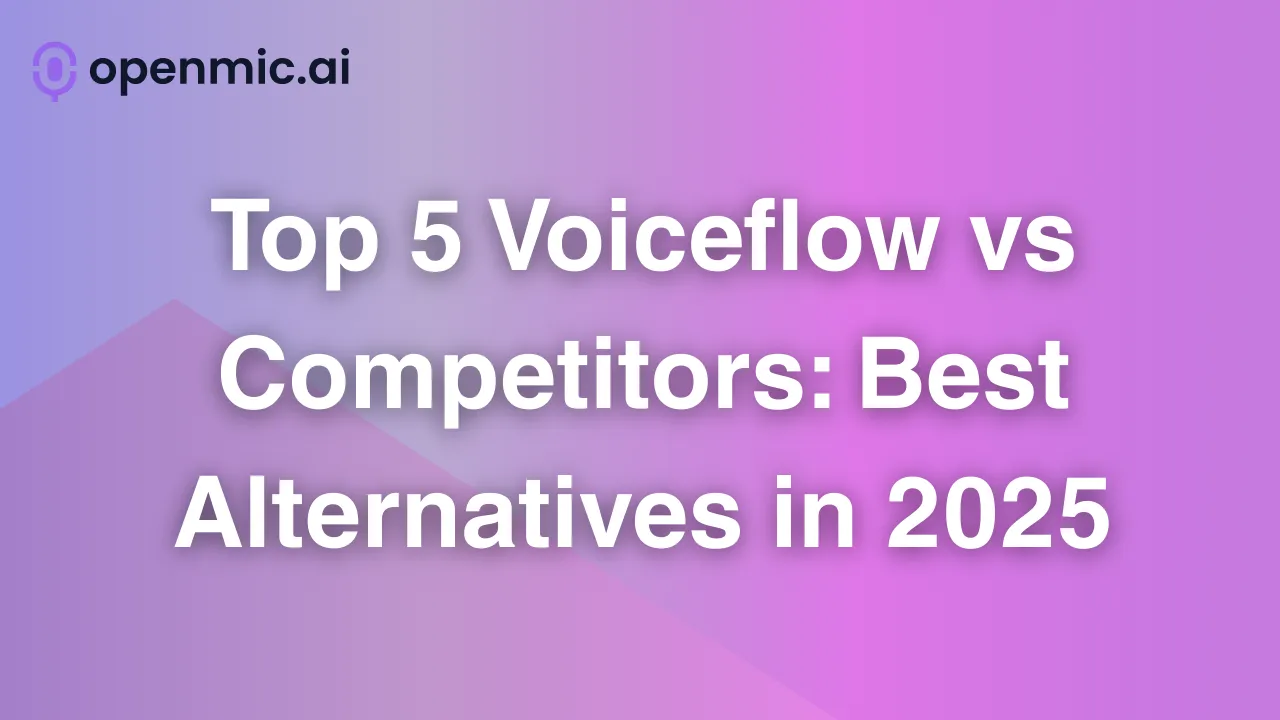
Top 5 Voiceflow vs Competitors: Best Alternatives in 2025
Why Look Beyond Voiceflow?
Voiceflow introduced many teams to no-code voice agent building. However, several limitations have pushed users toward newer alternatives:
Voice Quality Issues
Many users report that Voiceflow agents sound mechanical and lack the natural flow needed for professional customer interactions. The text-to-speech quality often fails to meet modern expectations.
Latency Problems
Real-time conversations require instant responses. Voiceflow's dependency on multiple third-party APIs creates delays that make conversations feel awkward and unnatural.
Limited Customization
While Voiceflow markets itself as flexible, users quickly discover restrictions in voice tone control, conversation flow customization, and integration options.
Complex Pricing Structure
Voiceflow's pricing becomes expensive fast. Hidden charges for minutes, features, and support add up quickly, making it costly for growing businesses.
Integration Challenges
Connecting Voiceflow with existing business tools often requires workarounds or additional software, creating more complexity than necessary.
What Makes a Great Voice AI Agent Platform in 2025?
Before diving into alternatives, here are the key features that matter most for voice ai agent in 2025:
Natural Voice Quality: Agents must sound human, not robotic. Clear pronunciation and natural pacing make the difference between professional and amateur implementations.
Zero Latency: Conversations should flow without noticeable delays. Any lag disrupts the experience and makes interactions feel artificial.
Easy Setup: Teams need platforms they can use immediately. Complex technical requirements slow down implementation and increase costs.
Flexible Integrations: Your voice agent should connect seamlessly with existing CRM systems, calendars, and business tools without custom coding.
Transparent Pricing: No surprises. Clear pricing that scales predictably with usage helps teams budget effectively.

Top 5 Voiceflow Alternatives in 2025
1. OpenMic AI - The Complete Solution
OpenMic AI emerges as the clear winner for businesses seeking a powerful Voiceflow alternative. This platform delivers everything users wish Voiceflow provided: natural voices, instant responses, and seamless integrations.
Key Features:
- Sub-second response times for natural conversations
- Human-quality voices that pass the natural test
- No-code setup that gets agents running in minutes
- Direct integration with 5000+ apps and business tools
- Real-time data access and CRM updates
- Both inbound and outbound calling capabilities
- Transparent per-minute pricing starting at $0.01
Why Choose OpenMic AI:The platform eliminates Voiceflow's biggest problems. No more robotic voices or conversation delays. OpenMic AI uses advanced technology to deliver professional-quality interactions that customers actually enjoy.
Setup takes minutes, not weeks. The drag-and-drop interface lets teams build sophisticated agents without technical expertise. Integration with popular tools like HubSpot, Salesforce, and Google Calendar happens automatically.
Pricing: Starting at $0.03 per second with free trial access. No hidden fees or surprise charges.
Best For: Any business wanting professional voice agents without technical complexity. Perfect for sales teams, customer service, appointment scheduling, and lead qualification.
Ready to experience the difference? Visit openmic.ai to see how OpenMic AI can transform your customer interactions.
2. Synthflow AI - Strong Voice Features
Synthflow AI offers solid voice capabilities with good customization options. The platform provides natural-sounding voices and reasonable setup times for most use cases.
Key Features:
- Quality voice synthesis with customization options
- No-code interface for agent building
- Integration with popular business tools
- Real-time conversation capabilities
- Multi-language support
Strengths:Good voice quality and user-friendly setup process. The platform handles basic to intermediate voice agent needs effectively.
Limitations:Higher pricing than competitors and limited advanced features compared to OpenMic AI.
Best For:Teams needing solid voice agents with straightforward requirements.
3. Vapi AI - Developer-Focused Platform
Vapi AI targets developers who want control over voice agent implementation. The platform offers flexible APIs and customization options for technical teams.
Key Features:
- API-first approach for maximum flexibility
- Custom voice model integration
- Developer-friendly documentation
- Multiple integration options
- Scalable infrastructure
Strengths:Excellent for teams with development resources who need custom implementations.
Limitations:Requires technical expertise and longer setup times. Not ideal for non-technical teams seeking quick deployment.
Best For:Development teams building custom voice solutions with specific technical requirements.
4. Bland AI - Multi-Channel Approach
Bland AI provides voice agent capabilities alongside other communication channels. The platform aims to serve businesses needing diverse interaction methods.
Key Features:
- Multi-channel communication support
- Voice agent building tools
- Integration capabilities
- Scalable architecture
- Analytics and reporting
Strengths:Good option for businesses wanting voice agents as part of broader communication strategy.
Limitations:Voice quality and latency issues make it less suitable for primary voice interactions.
Best For:Teams needing multi-channel communication with voice as a secondary feature.
5. Retell AI - Budget-Conscious Choice
Retell AI offers basic voice agent functionality at competitive pricing. The platform serves businesses with simple voice automation needs.
Key Features:
- Low-code platform setup
- Basic voice synthesis capabilities
- Standard integration options
- Usage-based pricing model
- Essential analytics features
Strengths:Affordable entry point for basic voice agent testing and simple use cases.
Limitations:Limited advanced features and voice quality compared to premium alternatives.
Best For:Small businesses testing voice agents for the first time with minimal requirements.
Comparison Summary
Industry Applications
Voice ai agent in 2025 serves numerous industries with specific needs:
Healthcare: Appointment scheduling, patient follow-ups, and prescription reminders require HIPAA-compliant platforms with natural voices.
Real Estate: Lead qualification, property information, and showing scheduling benefit from intelligent voice agents that understand context.
Financial Services: Account inquiries, payment processing, and customer support need secure, professional-sounding agents.
Retail: Order tracking, customer service, and product information delivery work best with responsive, helpful voice interactions.
Legal: Client intake, appointment scheduling, and case updates require professional, trustworthy voice communication.
Making Your Choice
Selecting the right platform depends on your specific needs:
Choose OpenMic AI if you want:
- Professional voice quality that impresses customers
- Quick setup without technical complexity
- Transparent pricing that scales with growth
- Comprehensive integrations with existing tools
- Both inbound and outbound capabilities
Consider alternatives if you need:
- Heavy custom development (Vapi AI)
- Multi-channel communication (Bland AI)
- Budget testing only (Retell AI)
- Standard voice features (Synthflow AI)
For most businesses, OpenMic AI provides the best combination of quality, ease of use, and value. The platform solves Voiceflow's main problems while offering features that competitors struggle to match.
Getting Started
The voice AI agent landscape moves quickly. What worked last year might not serve your needs in 2025. Testing platforms before committing helps ensure you choose the right solution.
Most platforms offer free trials or demonstrations. Take advantage of these to experience voice quality, setup processes, and integration capabilities firsthand.
OpenMic AI stands out for its commitment to quality and user experience. The platform delivers professional results without requiring technical expertise or hidden costs.
Conclusion
Voice automation transforms customer interactions when implemented correctly. While Voiceflow introduced many teams to this technology, newer platforms like OpenMic AI deliver superior results with less complexity.
OpenMic AI provides the most complete solution with natural voices, instant responses, and seamless integrations. Synthflow AI offers solid voice features for standard needs. Vapi AI serves developers requiring custom implementations. Bland AI works for multi-channel strategies. Retell AI provides budget-friendly basic functionality.
The choice depends on your priorities, but for most businesses seeking professional voice automation, OpenMic AI delivers the best combination of quality, simplicity, and value.
Ready to transform your customer interactions? Discover how OpenMic AI can elevate your business communication at mailkarma.io and experience the future of voice automation today.
Frequently Asked Questions (FAQs)
Q: How quickly can I set up a voice agent with these platforms?
A: Setup time can vary widely depending on the platform. With OpenMic AI, you can be up and running in just a few minutes—no complicated onboarding or coding required. In contrast, other platforms may require several hours to even days, especially if their systems involve complex configurations or technical integrations.
Q: Do these platforms integrate with my existing CRM system?
A: Yes, most leading voice AI platforms offer CRM integration. However, OpenMic AI stands out by supporting seamless integration with over 5,000+ applications, including major CRMs like Salesforce, HubSpot, Pipedrive, and Zoho. This ensures your call data, lead info, and notes flow automatically into your existing system—no manual updates needed.
Q: What's the difference in voice quality between platforms?
A: Voice quality is a key differentiator. Many platforms still rely on outdated or robotic-sounding voices, which can feel impersonal to callers. OpenMic AI, on the other hand, offers natural, human-like voices with minimal latency—creating conversations that feel fluid, intelligent, and responsive. This improves caller satisfaction and builds trust instantly.
Q: How much does voice AI cost compared to hiring human agents?
A: Voice AI is far more cost-effective than traditional human staffing. On average, it costs 70–90% less than hiring live agents. OpenMic AI simplifies pricing with a flat rate of $0.03 per second, giving you predictable costs without hidden fees or long-term contracts.
Q: Can voice agents handle complex customer inquiries or just basic tasks?
A: Today’s voice AI agents, especially those powered by OpenMic AI, are capable of far more than just answering basic questions. They can understand context, pull data in real time, schedule appointments, and even update your CRM or ticketing system. With the right configuration, they’re equipped to handle nuanced customer interactions just like a live representative.
Q: Is voice AI suitable for small businesses, or is it just for large enterprises?
A: Voice AI is actually a game-changer for small and mid-sized businesses. It allows you to offer 24/7 customer support, reduce staffing costs, and never miss a call—without hiring additional employees. OpenMic AI is particularly well-suited for small businesses thanks to its affordable pricing, easy setup, and scalable automation features.
Explore related blogs
.png)
Voice AI for Mass Tort Lawyers: How Conversational AI Is Revolutionizing Case Intake & Client Engagement
.png)
Top 5 AI Answering Services for Law Firms in 2025 (24/7 Reception & Intake)
.png)
Top 5 White-Label Voice AI Platforms in 2025 (Best for Agencies & SaaS Providers)
Let AI Handle Your Phones So You Can Focus on Growth
Start your free trial and see how OpenMic’s AI voice agents can streamline calls, boost conversions, and deliver fast, 24/7 customer service — without hiring more staff.






.svg)